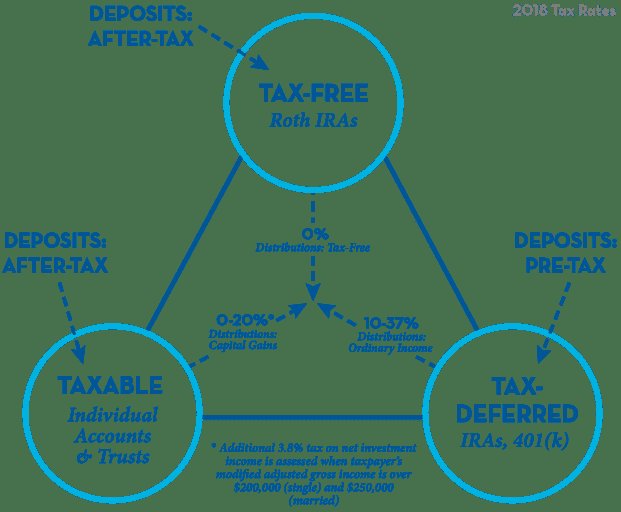Are you curious about what a tax-deferred investment account is? Look no further! In simple terms, a tax-deferred investment account allows you to postpone paying taxes on the growth of your investments until you withdraw the funds. It’s like giving your money a break from taxes and letting it work harder for you. This type of account offers a smart solution for individuals looking to maximize their investment returns while minimizing their tax liabilities. So, if you’re eager to learn more about tax-deferred investment accounts and how they can elevate your financial strategy, keep reading!
What Is a Tax-Deferred Investment Account?
A tax-deferred investment account refers to an investment vehicle that offers individuals the opportunity to postpone the payment of taxes on the earnings and growth of their investments until a later date. This type of account allows investors to potentially accumulate more wealth over time by taking advantage of the power of compounding. Tax-deferred investment accounts are widely used by individuals to save for retirement, education expenses, or other long-term financial goals.
The Basics of Tax-Deferred Investment Accounts
Tax-deferred investment accounts are governed by specific tax laws and regulations. By deferring taxes on investment earnings, individuals can keep more of their money invested and potentially benefit from the power of compound interest. The two common types of tax-deferred investment accounts are Individual Retirement Accounts (IRAs) and employer-sponsored retirement plans like 401(k)s.
Individual Retirement Accounts (IRAs)
An Individual Retirement Account (IRA) is a personal savings account that offers tax advantages for retirement savings. There are two main types of IRAs: Traditional IRAs and Roth IRAs. Let’s take a closer look at each:
Traditional IRAs
Traditional IRAs allow individuals to make tax-deductible contributions to their retirement savings. This means that the contributions made to a Traditional IRA can be deducted from the individual’s taxable income in the year they are made. The earnings on these contributions grow tax-deferred until they are withdrawn during retirement. However, when the funds are withdrawn, they are subject to income tax.
Roth IRAs
Roth IRAs, on the other hand, work slightly differently. Contributions to a Roth IRA are made with after-tax dollars, meaning they are not tax-deductible. However, the earnings on these contributions grow tax-free, and qualified withdrawals are also tax-free. This means that individuals who expect to be in a higher tax bracket during retirement may benefit from contributing to a Roth IRA.
Employer-Sponsored Retirement Plans
Many employers offer retirement savings plans to their employees, such as 401(k)s, 403(b)s, and 457 plans. These plans are tax-deferred investment accounts that allow employees to contribute a portion of their salary and invest it for retirement. Employers may also make matching contributions to encourage employees to save for their future.
401(k) Plans
A 401(k) plan is an employer-sponsored retirement plan available to employees of private companies. Employees can contribute a portion of their pre-tax salary to the plan, reducing their taxable income for the year. The contributions and earnings within the 401(k) account grow tax-deferred until withdrawal during retirement. At retirement, the withdrawals from a 401(k) account are subject to income tax.
403(b) Plans
403(b) plans are similar to 401(k) plans but are specifically designed for employees of public schools, universities, and certain tax-exempt organizations. They offer the same tax advantages as 401(k) plans, allowing employees to contribute a portion of their pre-tax salary and have the earnings grow tax-deferred until retirement.
457 Plans
457 plans are deferred compensation plans available to government employees and some non-profit organizations. Similar to 401(k) and 403(b) plans, contributions to a 457 plan are made with pre-tax dollars, and the earnings grow tax-deferred until withdrawal.
Benefits of Tax-Deferred Investment Accounts
Tax-deferred investment accounts offer several benefits to individuals who are saving for retirement or other long-term financial goals. Here are some key advantages:
1. Tax Deferral: The primary benefit of tax-deferred investment accounts is the ability to postpone paying taxes on earnings and growth until withdrawal. This allows individuals to keep more money invested, potentially earning additional returns over time.
2. Compound Growth: By reinvesting earnings without the burden of immediate taxes, tax-deferred accounts can experience the power of compound growth. This means that both the initial investment and the accumulated earnings generate additional returns, further boosting the account balance.
3. Lower Taxes in Retirement: Many individuals expect to have a lower income during retirement than during their working years. By deferring taxes until retirement, when they may be in a lower tax bracket, individuals can potentially pay less in taxes on their investment earnings.
4. Employer Contributions: Employer-sponsored retirement plans often include employer contributions, such as matching contributions. This is essentially “free money” that can significantly boost an individual’s retirement savings.
5. Flexible Withdrawal Options: While the main purpose of tax-deferred investment accounts is to save for retirement, certain accounts may offer penalty-free withdrawals for qualified education expenses, first-time home purchases, or hardship circumstances. However, these withdrawals may still be subject to income tax.
Considerations and Drawbacks
While tax-deferred investment accounts provide many benefits, there are some considerations and drawbacks to keep in mind:
1. Early Withdrawal Penalties: Withdrawing funds from tax-deferred accounts before the age of 59 ½ may result in early withdrawal penalties and additional taxes. It is important to carefully plan and budget for retirement to avoid the need for early withdrawals.
2. Required Minimum Distributions (RMDs): Traditional IRAs and employer-sponsored retirement plans require individuals to start taking required minimum distributions (RMDs) once they reach the age of 72 (or 70 ½ for individuals born before July 1, 1949). Failing to take the RMD can result in IRS penalties.
3. Income Tax on Withdrawals: While tax-deferred accounts provide tax advantages during the accumulation phase, withdrawals are subject to income tax. It is crucial to consider the potential tax implications when planning for retirement or other financial goals.
4. Contribution Limits: Tax-deferred accounts have annual contribution limits set by the IRS. It is important to stay within these limits to avoid penalties and maximize tax benefits.
5. Investment Options: The investment options within tax-deferred accounts can be limited compared to taxable brokerage accounts. While employer-sponsored plans often offer a variety of investment choices, individual IRAs provide more flexibility in selecting investment options.
In conclusion, tax-deferred investment accounts offer individuals a valuable tool for saving for retirement and other long-term financial goals. By taking advantage of the tax benefits and potential compounding growth, individuals can build a more secure financial future. It is essential to understand the specific rules and regulations associated with each type of tax-deferred account and consider personal financial circumstances when deciding on the most suitable investment strategy. Remember to consult with a financial advisor or tax professional to ensure proper guidance and maximize the benefits of tax-deferred investment accounts.
Ultimate Guide to Tax Free Investments
Frequently Asked Questions
Frequently Asked Questions (FAQs)
What is a tax-deferred investment account?
A tax-deferred investment account is a type of investment account where individuals can contribute pre-tax income, allowing their investments to grow tax-free until withdrawals are made in the future.
How does a tax-deferred investment account work?
When you contribute funds to a tax-deferred investment account, the money is deducted from your taxable income for that year. Any earnings within the account, such as dividends or capital gains, are not subject to immediate taxation. However, you will be taxed when you withdraw funds from the account in the future.
What are the advantages of a tax-deferred investment account?
One major advantage of a tax-deferred investment account is the potential for tax savings. By deferring taxes on earnings until withdrawal, you may be able to take advantage of lower tax rates in retirement. Additionally, the tax-advantaged growth can potentially accelerate your investment returns over time.
What types of investments can be held in a tax-deferred investment account?
Tax-deferred investment accounts can hold a variety of investments, including stocks, bonds, mutual funds, index funds, exchange-traded funds (ETFs), and certain annuities. The specific investment options available depend on the financial institution or custodian holding the account.
Are there contribution limits for tax-deferred investment accounts?
Yes, tax-deferred investment accounts have contribution limits set by the government. The limits may vary depending on the specific type of account, such as a 401(k), individual retirement account (IRA), or health savings account (HSA). It’s important to stay within these limits to avoid penalties or potential tax implications.
Can I access the funds in a tax-deferred investment account before retirement?
While tax-deferred investment accounts are primarily designed for long-term retirement savings, there are certain circumstances where you may be able to access the funds earlier. However, early withdrawals from these accounts are typically subject to taxes and penalties, so it’s important to consult with a financial advisor or tax professional before making any early withdrawals.
What happens to a tax-deferred investment account when I retire?
Upon retirement, you have several options for your tax-deferred investment account. You can choose to start making withdrawals, which will be subject to taxation at your ordinary income tax rate. Alternatively, you may consider converting the account into an income stream through annuities or other withdrawal strategies.
Are there any risks associated with tax-deferred investment accounts?
Like any investment, tax-deferred investment accounts carry some level of risk. The specific risks depend on the investments held within the account. It’s important to diversify your investments and carefully consider your risk tolerance and investment goals when managing a tax-deferred investment account.
Final Thoughts
A tax-deferred investment account is a financial tool that allows individuals to save and invest money without having to pay taxes on the earnings until withdrawal. This type of account, such as an Individual Retirement Account (IRA) or a 401(k), offers a way to grow investments over time while deferring taxes on the gains. By contributing to a tax-deferred investment account, individuals can potentially reduce their taxable income in the present and enjoy tax advantages in the future. It is important to understand the specific rules and limitations of these accounts in order to maximize their benefits and achieve long-term financial goals.

